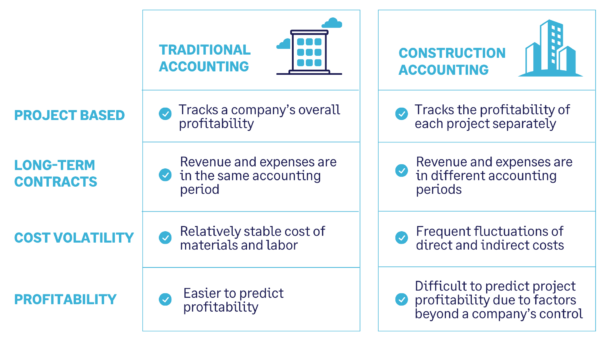Mastering Building And Construction Accountancy: Vital Tips for Financial Success in the Industry
Mastering building accountancy is an essential component for financial success within the industry, as it encompasses different methods that directly effect job earnings. Discovering these forgotten approaches might disclose possibilities that can transform your technique to building accountancy.
Comprehending Building Accountancy Fundamentals
Comprehending the basics of building bookkeeping is important for effective project monitoring and economic oversight in the building and construction market. Building bookkeeping differs dramatically from typical audit methods because of the unique obstacles postured by project-based work, including variable prices, changing timelines, and complicated regulatory needs.
A crucial aspect of construction accounting is job setting you back, which includes tracking expenditures for every specific task. This technique allows service providers to precisely assess earnings and make informed economic decisions. In addition, building accounting includes using development billing, where billings are issued based on the percent of work finished, guaranteeing cash money flow is kept throughout the project lifecycle.
One more critical element is the management of modification orders, which stand for modifications to the initial agreement scope. Appropriate documentation and bookkeeping for these adjustments are important to stop financial conflicts and ensure accurate job budgeting.
Last but not least, understanding the value of conformity with industry policies and tax needs is extremely important. Accurate monetary coverage and adherence to accountancy criteria not only safeguard against lawful concerns yet additionally enhance the integrity of building and construction companies. Mastering these basics sets the foundation for efficient monetary management within the building and construction field.
Effective Project Budgeting Techniques
Effective task budgeting methods are essential for ensuring that building and construction jobs remain monetarily practical and on track. A well-structured budget offers as a roadmap, directing task managers via the complexities of construction prices.
Next, using historical information from past tasks can considerably enhance the accuracy of spending plan quotes. By analyzing previous expenses, groups can determine price patterns and possible mistakes. In addition, engaging stakeholders throughout the budgeting process promotes transparency and secures buy-in, which can minimize disputes in the future.
In enhancement, adopting a comprehensive line-item spending plan enables careful monitoring of costs connected with products, labor, and expenses. This granularity enables job supervisors to recognize variances early and change approaches accordingly. Additionally, integrating backup allocations within the budget can help represent unpredicted expenses, safeguarding the job versus economic pressure.
Last but not least, regular budget evaluates throughout the job lifecycle make sure that economic purposes continue to be aligned with project goals, facilitating timely interventions when required. Carrying out these methods can significantly add to the economic health and success of construction projects.
Streamlining Cost Tracking Processes
Accurate cost tracking procedures are important in the building industry, as they frequently determine the financial success of a project. Efficient monitoring permits job managers to keep an eye on costs in real-time, ensuring they continue to be within budget plan and can make enlightened decisions quickly. To enhance these processes, it is vital to adopt a systematic strategy that incorporates innovation and recognized protocols.
First, making use of specific construction accounting software program can automate information entry and coverage, lessening human error and raising effectiveness. construction accounting. Such software application frequently consists of functions for tracking labor, materials, and subcontractor expenses, offering a thorough sight of project expenses
Second, systematizing procedures for videotaping expenses throughout projects boosts consistency and streamlines evaluation. Establishing a clear graph of accounts tailored to the special needs of building and construction projects can assist in accurate categorization of expenditures.
Lastly, routine training for team on the significance of specific cost tracking and the devices used in the procedure promotes liability. By executing these approaches, building and construction firms visit can substantially boost their cost tracking procedures, leading to enhanced monetary control and task profitability. Inevitably, a well-structured strategy to cost tracking lays the foundation for successful job monitoring and lasting monetary sustainability.
Taking Care Of Capital Effectively

On a regular basis monitoring capital declarations is important. By examining cash inflows and outflows, companies can determine trends and potential shortfalls. This technique assists in timely adjustments to costs or repayment routines, stopping money lacks that might endanger job timelines.

Last but not least, maintaining a monetary cushion or line of debt can offer a security net during lean durations. Making use of these strategies will certainly lead to an extra secure monetary structure, allowing construction companies to browse the market's fundamental unpredictabilities with higher confidence.
Staying Clear Of Common Accounting Risks
In the complex landscape of construction audit, preventing typical pitfalls is necessary for preserving economic stability and project success. One widespread issue is inadequate record-keeping. Building and construction jobs typically involve countless deals, and click this site falling short to record them effectively can cause discrepancies and monetary losses. It is critical to apply a durable system for tracking expenditures, labor, and products.
An additional risk is the mismanagement of adjustment orders. Change orders are a natural component of construction projects, but without proper audit for these changes, firms may have a hard time to redeem costs. Developing a clear process for documenting and approving adjustment orders can alleviate this danger.
Additionally, overlooking to fix up accounts frequently can cause unreliable monetary declarations and hinder decision-making. Routine reconciliation ensures that documents align with financial institution statements and project paperwork.
Last but not least, neglecting tax obligations can have severe consequences. It is important to stay informed regarding tax obligation guidelines particular to the construction industry, including sales tax on materials and labor.
Final Thought
Grasping building and construction bookkeeping is critical for accomplishing monetary success within the market. By implementing effective work setting you back, utilizing development invoicing, and keeping thorough documents for adjustment orders, recommended you read firms can boost financial monitoring. The assimilation of customized audit software application additionally streamlines expense monitoring, while regular budget plan assesses make sure that economic purposes remain aligned. Prioritizing conformity and dealing with usual bookkeeping risks solidifies reputation and supports long-lasting success, eventually cultivating a lasting affordable advantage in the construction market.